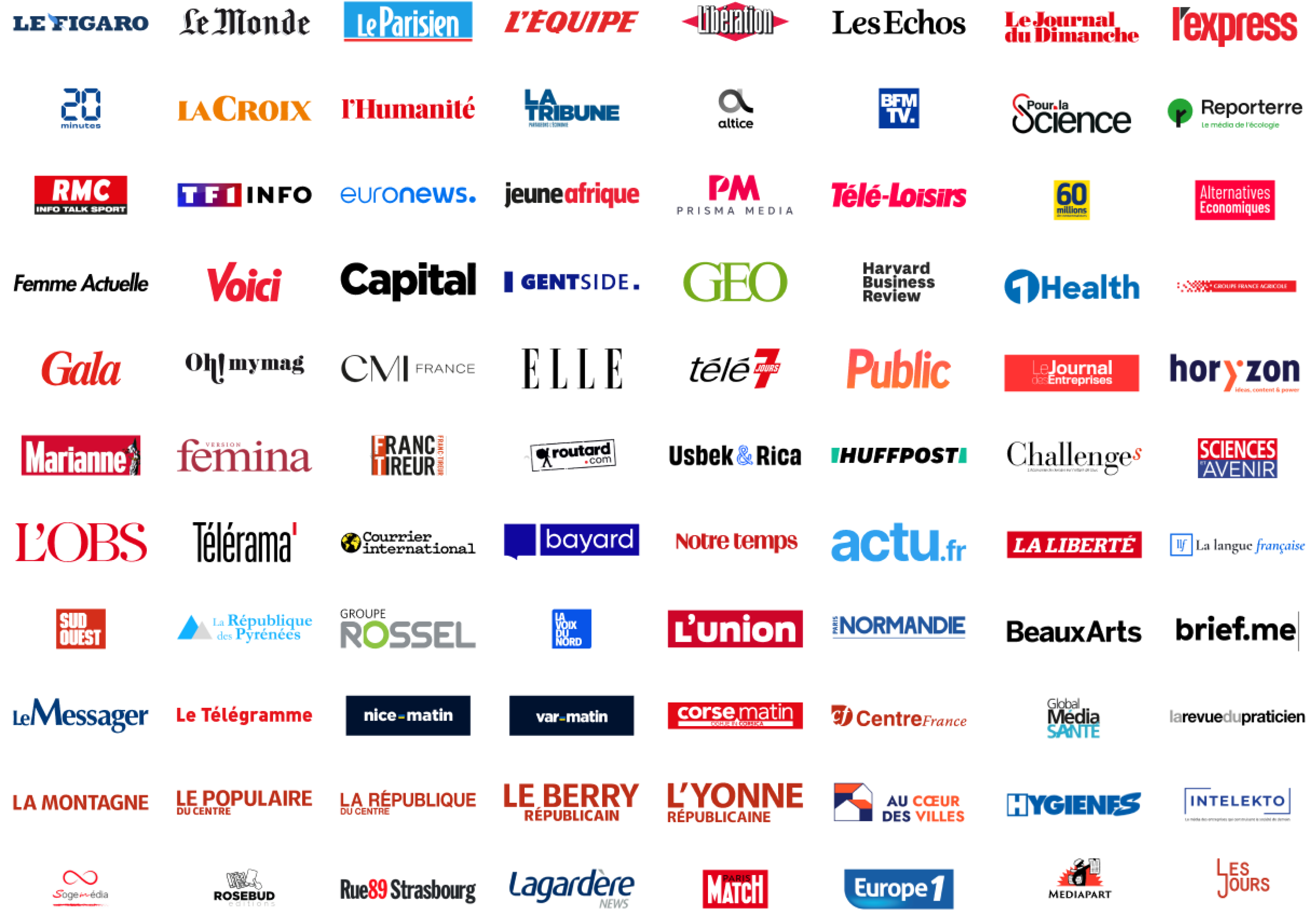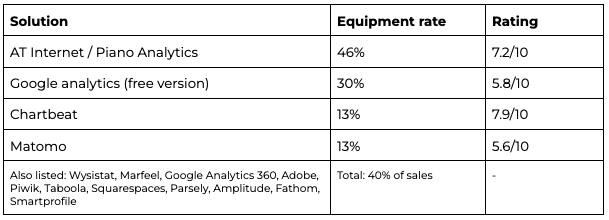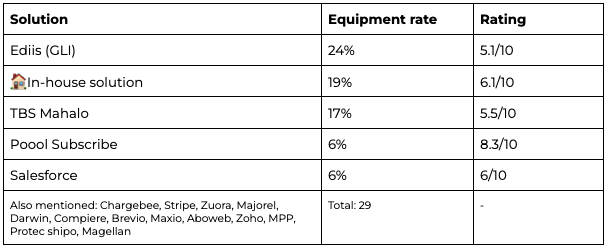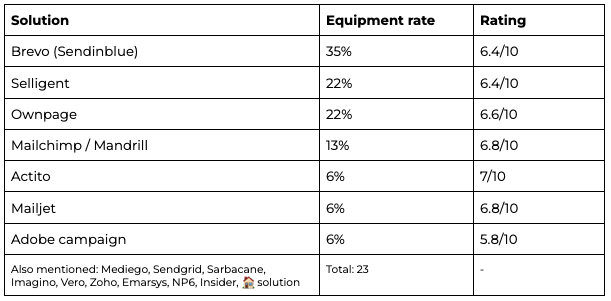

Despite the difficulty in selecting the right solutions and its importance for a successful digital strategy, surprisingly few publishers share their choice of tech stack with others on the market. With licences, developments, start-ups, plug-ins, customizations and updates, publishers are expected to manage a rapidly evolving technical panoply with fairly limited guidance. It's for this reason that the renowned French university, Science Po, launched the Tech Stack Study in 2022, providing a complete overview of the most widely used solutions by French news publishers whilst guaranteeing each respondent confidentiality of the solutions with which they are seeking a competitive advantage.
The “Tech Stack Study 2023” survey is based on responses from a wide variety of French press publishers and, in particular, from professionals using these tools, including CTOs, editorial managers, product managers and marketing managers.
Respondent profiles are varied, both in terms of media size and press family. Survey participants include:
- The majority of national daily press titles in France
- Some audiovisual media brands (radio, TV)
- Magazine titles: general, business and entertainment weeklies,
- Regional press groups: daily and weekly,
- Pure-players (websites without print versions)
- Some trade press groups
If we add up the audiences of each participating title, this study describes the Tech Stack behind 5.3 billion monthly page views.

Between their in-house tools and those supplied by external providers, they all manage a rapidly evolving space, with licenses, developments, plug-ins, customizations and updates.
Producing content in the publishing industry therefore involves a constant choice of resources. This study bears witness to the complexity of the task given the immense range of possibilities.
The tools cited
In all, eleven tools are cited by more than a third of respondents as being part of their Tech Stack, a sign of the vendors’ solid penetration of the French market.
Those on this list are:
- Google Ad Manager (Adserver) – used by 57% of respondents
- Didomi (Consent Management Platform) – 57%
- Poool Access (Paywall) – 49%
- Piano Analytics (Analytics) – 46%
- Youtube (Video player) – 43%
- Adobe Premiere Pro (Video Lives) – 38%
- Google Data Studio (Dataviz) – 37%
- Datawrapper (Editorial infographics) – 35%
- Brevo / Sendinblue (Emailing/CRM) – 35%
- Batch (Push notifications) – 33%
- Google Workspace (Editorial planning) – 33%
The power of Google and its parent company Alphabet Inc. is clear in this study, where the company’s tools appear in 9 categories of the study. Comments from respondents make it clear that some deplore this power and extensive presence.
In-house solutions
In almost every category, publishers are moving away from off-the-shelf tools to produce their own technology in-house. Only in four areas, however, does this option rank as the most widely used solution:
- CMS
- Live text tools
- Contribution managers (comments, debates)
- Firewalls
On the other hand, we note the absence of in-house solutions in the following categories:
- Analytics
- Data visualization tools
- Editorial graphics
- Speech to text
- Live video cutting
Tools in trouble
As in previous years, some tool categories show a very low satisfaction rate:
- Subscription managers score an average of 5.8/10, the lowest score.
- Community tools (comments, debates) don’t do much better, with an average of 6/10.
- DMP/CDP peak at 6.3/10.
On the other hand, a number of tools that boasted a significant market share in 2022 no longer appear in the 2023 results. While some have simply disappeared, others seem to have lost interest as publishers opt for competitors.
Deep dive into some key tool categories
Analytics
Average rating: 6.7/10
There’s a wide range of tools in this category, combining site-centric audience analytics and real-time monitoring. And this is increasingly the case across Europe as institutions such as France’s CNIL questions Google Analytics, thus benefiting other solutions on the market.
Media companies are looking for analytics tools that are intuitive, easy to use, scalable and enable in-depth analysis with an easy-to-read dashboard. Adapting to confidentiality concerns and the question of cost play a crucial role in the choice of these solutions.

Notes on the results:
- 43% of respondents use at least 2 analytics solutions, often complementary
- If we add up the 2 versions of Google (free and premium), the amount of tech originating from Google has dropped to 38% vs. 51% in 2022. This drop can be explained by the considerable legal uncertainty linked to Google in Europe
- Analytics expectations are growing: funnel analysis, navigation sequence analysis, loyalty analysis, creation of advanced segments…
Notable comments from respondents:
“Combining several tools provides a good complementarity between site-centric and real-time audiences”.
“We need better management of privacy issues”.
“The downside: we don’t own our data”.
“UX notions like scroll views are missing”.
Subscription manager
– Average rating: 5.8/10
With subscription at the heart of many publishers’ business models, it’s vital that they equip themselves with the right tools. Many players are present in this market, where expectations are high, but satisfaction is not always the same.
Faced with this lack of effective solution, a number of publishers have developed their own in-house solution, enabling them to control the subscription process internally, but they are only moderately satisfied with it.

Notes on the results:
- There’s strong competition in this category: 17 suppliers are cited
- Ratings for these tools aren’t great: half of respondents gave their subscription management solution a rating of 5 or less
Notable comments from respondents:
“Print-first solutions no longer meet the needs of digital subscriptions.
“Our subscription management solution is unfortunately not very scalable, and requires a lot of effort to integrate with other systems in our stack.”
“The in-house solution lacks full control”.
Paywall solution
– Average rating: 6.9/10
For publishers, choosing a paywall and understanding its potential (dynamicity, scalability, testing, etc), plays a crucial role in their subscription strategy and thus in their sustainability.
Requirements for this solution need to balance tech performance (fast display, ability to be bypassed, web performance, etc) and conversion rate performance, alongside allowing for a smooth user experience.

`Notes on the results:
- Several publishers have now added a <3dynamic parameter-setting tool to their in-house solutions.
- In-house solutions are rated very highly, and publishers talk about reliable, fast, secure and high-performance paywalls.
- External solutions provide dynamization, personalization and A/B testing.
Notable comments from respondents:
“Total control, overall efficiency and safety. Will ask to become more flexible/agile.”
“Technical performance and webperf to work on: CLS…”
“Needs more features. Undergoing evolution to make it more “intelligent”.
“Our tool allows us to set up a number of interesting scenarios that encourage newsletter sign-ups and subscriptions.”
> 5 simple hacks to increase paywall conversion rates
E-mailing / CRM
– Average rating: 6.7/10
Newsletters play a central role in engagement strategies, subscriber loyalty and churn reduction, and the success of these newsletters depends partly on the use of high-performance CRM/email tools. Expectations include simple editing for editors, optimal deliverability, advanced audience segmentation, in-depth performance analysis, connections with other tools in the stack, and technical support adapted to frequent mailings. A wide range of suppliers offer solutions to meet these needs.

Notes on the results:
- More than one in three use several solutions at the same time, as each addresses different needs: newsletter editing, targeting and routing of editorial emails, marketing emails…
- In terms of expectations, deliverability is key. For instance, the tool must manage unsubscribing, an essential point for the RGPD, and perfect mobile compatibility is essential
- Respondents believe that solutions could be more powerful by making greater use of AI, which is little used today
Notable comments from respondents:
“The editorial team has really got to grips with the solution, and it saves us an enormous amount of time in administering all our newsletters”.
“The tool gives us a high degree of autonomy when it comes to animating marketing campaigns”.
“2 tools are one too many”.
“Robust but expensive”
CMS
– Average rating: 6.9/10
Media groups have increasingly high expectations of CMS (Content Management System), the indispensable heart of the editorial team’s work. They expect it to be able to react quickly to their new challenges, and adapt fully to their own context. They are also counting on their CMS to transform internal practices and, in some cases, organizations.

Notes on the results:
- As a general rule, media companies undergoing change are moving towards in-house solutions. They’re therefore ready to make investments in this area to gain in agility. Those who have already taken this step say they are satisfied with their choice
Notable comments from respondents:
“Versatile, configurable, and designed with and for editorial staff”.
“Does the job, but doesn’t allow you to get productivity reports, to push the editorial team to write differently, to mutualize print and web”.
> Migrating 1.2 million articles to Arc XP: a look behind-the-scenes as l’Express changes CMS
For the full tech study and rating on each solution, download the report here or the table summary of results here. Note that it has been automatically translated from French by an online tool.
Special mention
This study would not have been possible without the instinct, eye and confidence of Jean-François Fogel, a professor affiliated with the Sciences Po School of Journalism and Executive Education. An “encyclopedist” of the press and a great transformer of journalistic practices in the digital age, Jean-François died on March 19, 2023. We dedicate this issue to him.












